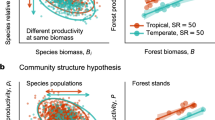Abstract
Climate change is driving latitudinal and altitudinal shifts in species distribution worldwide1,2, leading to novel species assemblages3,4. Lags between these biotic responses and contemporary climate changes have been reported for plants and animals5. Theoretically, the magnitude of these lags should be greatest in lowland areas, where the velocity of climate change is expected to be much greater than that in highland areas6. We compared temperature trends to temperatures reconstructed from plant assemblages (observed in 76,634 surveys) over a 44-year period in France (1965–2008). Here we report that forest plant communities had responded to 0.54 °C of the effective increase of 1.07 °C in highland areas (500–2,600 m above sea level), while they had responded to only 0.02 °C of the 1.11 °C warming trend in lowland areas. There was a larger temperature lag (by 3.1 times) between the climate and plant community composition in lowland forests than in highland forests. The explanation of such disparity lies in the following properties of lowland, as compared to highland, forests: the higher proportion of species with greater ability for local persistence as the climate warms7, the reduced opportunity for short-distance escapes8,9, and the greater habitat fragmentation. Although mountains are currently considered to be among the ecosystems most threatened by climate change (owing to mountaintop extinction), the current inertia of plant communities in lowland forests should also be noted, as it could lead to lowland biotic attrition10.
This is a preview of subscription content, access via your institution
Access options
Subscribe to this journal
Receive 51 print issues and online access
$199.00 per year
only $3.90 per issue
Buy this article
- Purchase on Springer Link
- Instant access to full article PDF
Prices may be subject to local taxes which are calculated during checkout



Similar content being viewed by others
References
Parmesan, C. & Yohe, G. A globally coherent fingerprint of climate change impacts across natural systems. Nature 421, 37–42 (2003)
Rosenzweig, C. et al. in Climate Change 2007: Impacts, Adaptation and Vulnerability (eds Parry, M. L. et al.) 79–131 (Cambridge Univ. Press, 2007)
Williams, J. W. & Jackson, S. T. Novel climates, no-analog communities, and ecological surprises. Front. Ecol. Environ 5, 475–482 (2007)
Wing, S. L. et al. Transient floral change and rapid global warming at the Paleocene-Eocene boundary. Science 310, 993–996 (2005)
Davis, M. B. in Community Ecology (eds Diamond, J. & Case, T. J. ) 269–284 (Harper and Row, 1986)
Loarie, S. R. et al. The velocity of climate change. Nature 462, 1052–1055 (2009)
Thuiller, W., Lavorel, S., Araujo, M. B., Sykes, M. T. & Prentice, I. C. Climate change threats to plant diversity in Europe. Proc. Natl Acad. Sci. USA 102, 8245–8250 (2005)
Jump, A. S., Matyas, C. & Penuelas, J. The altitude-for-latitude disparity in the range retractions of woody species. Trends Ecol. Evol. 24, 694–701 (2009)
Scherrer, D. & Korner, C. Topographically controlled thermal-habitat differentiation buffers alpine plant diversity against climate warming. J. Biogeogr. 38, 406–416 (2011)
Colwell, R. K., Brehm, G., Cardelus, C. L., Gilman, A. C. & Longino, J. T. Global warming, elevational range shifts, and lowland biotic attrition in the wet tropics. Science 322, 258–261 (2008)
Crimmins, S. M., Dobrowski, S. Z., Greenberg, J. A., Abatzoglou, J. T. & Mynsberge, A. R. Changes in climatic water balance drive downhill shifts in plant species' optimum elevations. Science 331, 324–327 (2011)
Doak, D. F. & Morris, W. F. Demographic compensation and tipping points in climate-induced range shifts. Nature 467, 959–962 (2010)
Lenoir, J. et al. Going against the flow: potential mechanisms for unexpected downslope range shifts in a warming climate. Ecography 33, 295–303 (2010)
Cannone, N., Sgorbati, S. & Guglielmin, M. Unexpected impacts of climate change on alpine vegetation. Front. Ecol. Environ 5, 360–364 (2007)
Hillebrand, H., Soininen, J. & Snoeijs, P. Warming leads to higher species turnover in a coastal ecosystem. Glob. Change Biol. 16, 1181–1193 (2010)
le Roux, P. C. & McGeoch, M. A. Rapid range expansion and community reorganization in response to warming. Glob. Change Biol. 14, 2950–2962 (2008)
Lenoir, J., Gegout, J.-C., Dupouey, J.-L., Bert, D. & Svenning, J.-C. Forest plant community changes during 1989–2007 in response to climate warming in the Jura Mountains (France and Switzerland). J. Veg. Sci. 21, 949–964 (2010)
Moritz, C. et al. Impact of a century of climate change on small-mammal communities in Yosemite National Park, USA. Science 322, 261–264 (2008)
Lenoir, J., Gegout, J.-C., Marquet, P. A., de Ruffray, P. & Brisse, H. A significant upward shift in plant species optimum elevation during the 20th century. Science 320, 1768–1771 (2008)
Brohan, P., Kennedy, J. J., Harris, I., Tett, S. F. B. & Jones, P. D. Uncertainty estimates in regional and global observed temperature changes: a new data set from 1850. J. Geophys. Res. Atmos. 111, D12106. 1–21 (2006)
Heikkilä, M. & Seppä, H. A 11,000 yr palaeotemperature reconstruction from the southern boreal zone in Finland. Quat. Sci. Rev. 22, 541–554 (2003)
Vennetier, M. & Ripert, C. Forest flora turnover with climate change in the Mediterranean region: a case study in Southeastern France. For. Ecol. Mgmt 258, S56–S63 (2009)
Primack, R. B. & Miao, S. L. Dispersal can limit local plant-distribution. Conserv. Biol. 6, 513–519 (1992)
Huntley, B. Evolutionary response to climatic change? Heredity 98, 247–248 (2007)
Jump, A. S. & Penuelas, J. Running to stand still: adaptation and the response of plants to rapid climate change. Ecol. Lett. 8, 1010–1020 (2005)
Jackson, S. T. & Sax, D. F. Balancing biodiversity in a changing environment: extinction debt, immigration credit and species turnover. Trends Ecol. Evol. 25, 153–160 (2010)
Walther, G. R. Community and ecosystem responses to recent climate change. Phil. Trans. R. Soc. B 365, 2019–2024 (2010)
Ninyerola, M., Pons, X. & Roure, J. M. A methodological approach of climatological modelling of air temperature and precipitation through GIS techniques. Int. J. Climatol. 20, 1823–1841 (2000)
ter Braak, C. J. F. & van Dam, H. Inferring pH from diatoms: a comparison of old and new calibration methods. Hydrobiologia 178, 209–223 (1989)
Breiman, L. Random forests. Mach. Learn. 45, 5–32 (2001)
Acknowledgements
We thank J.-D. Bontemps and P. Mérian for comments; V. Pérez, F. Lebourgeois and E. K. Cavalheri for help in the compilation of the meteorological database; V. Pérez for technical support in GIS; I. Seynave for management of the EcoPlant database; H. Brisse, J. Drapier and F. Morneau for contributions to the Sophy and NFI databases; and all who have participated in the conception of the EcoPlant, Sophy and NFI databases. The phytoecological database (EcoPlant) was funded by the French Institute of Agricultural, Forest and Environmental Engineering (ENGREF, AgroParisTech), the National Forest Department (ONF), and the French Agency for Environment and Energy Management (ADEME). J.L. acknowledges a grant from the Danish Council for Independent Research – Natural Sciences (272-07-0242 to J.-C. Svenning). This study was funded through a PhD grant to R.B. by ADEME and the Regional Council of Lorraine.
Author information
Authors and Affiliations
Contributions
R.B. designed the study, methodology and modelling approach, performed all the statistical analysis and wrote the paper; P.d.R. provided the Sophy database; C.V. provided the NFI database; J.-C.G. provided the EcoPlant database, helped to design the methodology and supervised the work; R.B. and G.R. contributed equally to format the floristic database; J.-C.P. advised the use of the Breiman’s random forest regression to infer temperatures from the plant assemblages; R.B. and C.P. contributed equally to compute the climate model of historic temperature prediction; J.L. contributed actively to improve the clarity of the paper. All authors discussed and commented on the results.
Corresponding author
Ethics declarations
Competing interests
The authors declare no competing financial interests.
Supplementary information
Supplementary Information
This file contains Supplementary Figures 1-10 with legends, Supplementary Methods, Supplementary Table 1 and additional references. (PDF 5173 kb)
Rights and permissions
About this article
Cite this article
Bertrand, R., Lenoir, J., Piedallu, C. et al. Changes in plant community composition lag behind climate warming in lowland forests. Nature 479, 517–520 (2011). https://doi.org/10.1038/nature10548
Received:
Accepted:
Published:
Issue Date:
DOI: https://doi.org/10.1038/nature10548
This article is cited by
-
Extinction drives recent thermophilization but does not trigger homogenization in forest understorey
Nature Ecology & Evolution (2024)
-
Integrating field- and remote sensing data to perceive species heterogeneity across a climate gradient
Scientific Reports (2024)
-
Prediction of habitat suitability dynamics and environmental factors of non-Gyps vultures for conservation in floristic landscapes of India
Landscape and Ecological Engineering (2024)
-
Predicting the impacts of climate change on potential suitability habitats of three Juniperus trees in Mexico
Plant Ecology (2024)
-
Climate influences on future fire severity: a synthesis of climate-fire interactions and impacts on fire regimes, high-severity fire, and forests in the western United States
Fire Ecology (2023)
Comments
By submitting a comment you agree to abide by our Terms and Community Guidelines. If you find something abusive or that does not comply with our terms or guidelines please flag it as inappropriate.



